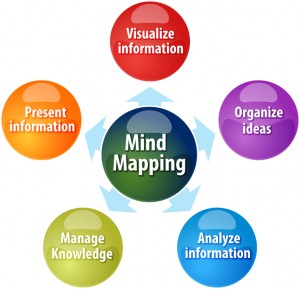Join our online community and be inspired to achieve your goals!
VIEW OUR FACEBOOK PAGE7 steps to creating a career Mind Map

Invented by Tony Buzan as a learning and memory tool while he was struggling to take effective notes as a student, a Mind Map is a diagram used to organise all kinds of information in a more visual and memorable way. Usually, Mind Maps are created around one single topic. An image is drawn in the centre of a blank piece of paper then ideas are added around it with key ideas linked directly to the central subject, and other ideas branching out from these.
A key factor to creating a successful Mind Map is the use of colour, images and curved lines to link ideas, which encourages brainstorming and makes it easier for our brains to remember. Since the human brain finds it easier to remember images rather than words, and it thinks in multiple directions simultaneously – a Mind Map can provide a more effective problem-solving and memory tool than written notes or lists.
There are several Apps and websites available to help you create your Mind Map, or you can simply grab a piece of A4 paper and some coloured pencils and do it the old fashioned way!
7 Steps:
Step 1: Start in the centre of a blank page turned sideways. Using the paper in landscape will give your brain the freedom it needs to spread out in all directions.
Step 2: Your central idea is your career – so start with this using an image or picture to represent it. This helps you to use your imagination because an image is more interesting to the brain than words.
Step 3: Draw your main branches connected to the central image and connect your second and third level branches to the first and second levels. Your brain works by association and likes linking things together in an orderly way. Connecting the branches will help you more easily visualise your primary areas of interest and come up with ideas that relate to them.
Step 4: Make your connecting lines curved rather than straight since curved lines are more
interesting to your brain. Use a combination of colours, images, and words – which again makes it more interesting to your brain and encourages creative thinking.
Step 5: Use one key word for your main branches and then start to brainstorm all the areas you need to consider – creating this wide array of ideas helps you gain a clearer picture of where you’d like to go and how you’re going to get there.
Step 6: Use images throughout your Mind Map because it is said that every image is worth a thousand words. That means if you have only 10 images in your Mind Map, it’s the equivalent of 10,000 words of notes!
Step 7: Once you have your mind map, use it as the basis to create an execution strategy or road map if you like that will help you achieve your career dreams.
A Mind Map is a creative outlet and should be approached with an open and uninhibited mind – try not to place any limits on yourself as to the number of thoughts, ideas and connections you make.
Ideas for sub-topics include your current job, your dream job, reasons why you want your dream job, key strengths, weaknesses or areas for improvement, core values – especially things that you won’t compromise, interests, lifestyle goals, possible or required training/education, limitations or barriers, areas where you want to work, areas where you don’t want to work, companies that interest you, and role models.
Katie Roberts Career Consulting Reviews – Career Counselling

